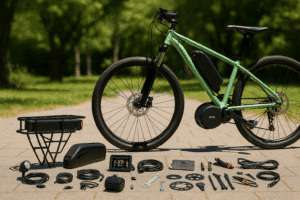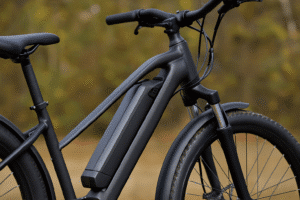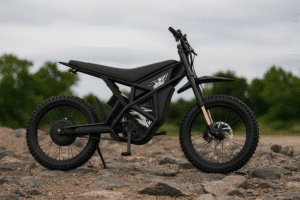If you’re wondering whether electric bikes are waterproof, you’re not alone. It’s a common question, especially for riders who commute in the rain or live in wetter climates.
While most e-bikes can handle a bit of water, there are limits. Here’s what really matters.
Key Takeaways:
- Electric bikes are water-resistant, not waterproof; they can handle rain, not submersion.
- IP ratings show how well each component resists dust and water.
- Motors, batteries, and displays require protection from high-pressure water and deep puddles.
- Regular care helps prevent water damage and extends your e-bike’s lifespan.
Are Electric Bikes Waterproof?
No, electric bikes are not waterproof. Most are water-resistant, which means they can handle light rain or splashes but should never be fully submerged.
Electric bikes have sensitive electrical parts like motors, batteries, and displays. These are usually sealed to block out water, but the protection has limits.
Ride through a puddle or get caught in light rain? That’s usually fine. But soak your bike in deep water or hit it with a pressure washer? That can damage the electronics or kill the battery.
Think of e-bikes like smartphones, some protection, but not invincible.
Water-Resistant vs. Waterproof: What’s the Difference?
Water-resistant means your e-bike can handle small amounts of moisture. Waterproof means it can survive full submersion without damage, and e-bikes are not built for that.
Here’s a quick comparison:
| Feature | Water-Resistant | Waterproof |
|---|---|---|
| Light rain | Yes | Yes |
| Riding through puddles | Usually safe | Safe |
| Heavy rain | Risky if prolonged | Safe |
| Submersion in water | Not safe | Safe |
| Pressure washing | Not recommended | Okay (with high IP rating) |
Most electric bikes are built with water resistance in mind. But unless the manufacturer explicitly says a part is waterproof (and gives a high IP rating), it’s better to play it safe.
Are E-Bikes Safe to Ride in the Rain?
Yes, you can ride most electric bikes in the rain. As long as it’s not a downpour or flood, your e-bike should be fine.
Light to moderate rain is usually not a problem, especially if your bike has sealed components and a decent IP rating. You’ll want to slow down, brake earlier, and be extra cautious around slick surfaces like painted lines or metal grates.
However, avoid deep puddles or streams. Water can splash into places it shouldn’t, like your motor or battery terminals.
Always dry your bike off when you get home. A soft cloth around the motor, display, and battery connection points goes a long way.
Understanding IP Ratings on E-Bikes
To really know how water-resistant your e-bike is, you’ll want to look at something called the IP rating. This little code tells you how well each part of the bike holds up against dust and water.
What Is an IP Rating?
An IP (Ingress Protection) rating tells you how well a component resists dust and water. It’s written as IP followed by two numbers.
- The first number is for dust protection (0 to 6).
- The second number is for water protection (0 to 8).
Here’s how to read them:
| IP Rating | Dust Protection | Water Protection |
|---|---|---|
| IP65 | 6 = Dust tight | 5 = Water jets from any direction |
| IP66 | 6 = Dust tight | 6 = High-pressure water jets |
| IP67 | 6 = Dust tight | 7 = Temporary submersion (up to 1 meter for 30 mins) |
Common Ratings You’ll See on E-Bikes
- Battery: IP65–IP67; these are sealed pretty well. Most can handle rain or splashes, but still avoid dunking them.
- Motor: IP65, good enough for light rain and mud, but not for riding through floodwaters.
- Display: This varies a lot. Some are IP65, but others are less protected. If your screen isn’t rated, keep it dry as much as you can.
Even if each part has its own IP rating, the weakest link still matters. A waterproof battery won’t help if water gets into the display or wiring.
How to Check Your E-Bike’s Water Resistance
The easiest way to check your e-bike’s water resistance is by looking for its IP rating. You can usually find this in the owner’s manual, on the product label, or on the manufacturer’s website.
If you can’t find an IP rating, check the specs of key components like the battery, motor, and display. Not all e-bikes will list a full-bike rating, so it’s common for each part to have its own.
If your bike doesn’t show any water resistance info, assume it’s not built for wet conditions and ride with extra caution.
Which Parts Are Most Vulnerable to Water?
Not all components are sealed the same. Some are better protected than others.
- Battery terminals: Water here can cause short circuits or corrosion.
- Display units: Many are less sealed and can fog up or fail when wet.
- Wiring and connectors: Exposed or loosely connected wires can let water in.
- Motor (especially mid-drive): If seals wear out, water can sneak in over time.
- Charging ports: Always cover them when not in use, especially outdoors.
Tips to Ride Safely in Wet Conditions
Riding in the rain is possible, but you’ve got to be smart about it.
- Use fenders or mudguards: These block water from splashing onto your legs, motor, and battery.
- Slow down and increase your stopping distance: Wet roads reduce grip and braking power. Ride more cautiously and start braking earlier.
- Avoid deep puddles: You don’t know what’s underneath, and water can reach parts it shouldn’t.
- Use lights and wear bright or reflective gear: Rain reduces visibility. Make sure you’re easy to see for cars and other cyclists.
- Check your tires: Worn tires lose grip fast in the rain. Consider switching to wider or grippier treads in wet seasons.
Protecting Your E-Bike from Water Damage
Even if your e-bike is rated for water resistance, it’s still smart to take care during wet rides. Small habits can make a big difference in how long your bike lasts.
Before the Ride
- Check the weather forecast.
- Cover exposed connectors and ports.
- Use a frame cover if your display or battery is lightly protected.
- Add fenders if your bike doesn’t have them.
During the Ride
- Avoid deep water, mud, and flooded paths.
- Ride slower and use gentle braking.
- Stay upright and avoid leaning too much into turns.
After the Ride
- Turn off the power and remove the battery.
- Wipe down your bike, especially around the motor, battery area, and display.
- Store the bike in a dry spot or use a waterproof cover.
- Check connectors and seals for any trapped moisture or dirt.
Can You Wash an Electric Bike with Water?
Yes, you can rinse an electric bike with water, but avoid pressure washers and don’t spray directly at electrical parts. Use a gentle stream and take extra care around the motor, battery, and display.
It’s best to treat your e-bike like a sensitive electronic device. Use a damp cloth or low-pressure hose to clean dirt off the frame.
Skip the pressure washer; it can force water past seals and damage internal components. Always dry off your bike after cleaning, especially near connections and the battery compartment.
What to Do If Your E-Bike Gets Wet or Submerged
If your e-bike gets soaked or accidentally submerged, act fast to reduce the risk of permanent damage.
- Turn off the power immediately.
- Remove the battery and store it in a dry, well-ventilated space.
- Dry the bike with a soft cloth, focusing on electrical parts.
- Avoid turning it back on until everything is fully dry.
- Inspect for moisture in the battery compartment, display, and wiring.
- Let the bike air dry indoors for at least 24 hours.
- If you’re unsure, take it to a bike shop or e-bike technician for inspection.
Do Any E-Bikes Offer Better Water Protection?
Some electric bikes are built with higher water resistance, but no e-bike is truly waterproof. The level of protection usually depends on the IP ratings of individual components.
Higher-end or off-road e-bikes often have better sealing around their motors and batteries. These models are designed to handle harsher conditions like wet trails, mud, or rainy commutes.
Look for bikes where the battery and motor housing are tightly enclosed and IP-rated.
That said, even the most rugged e-bike has limits. Water can sneak in through weak points like the display or wiring.
So no matter how well-sealed your e-bike is, good care and regular maintenance still matter.
Storage Tips for Rainy Seasons or Wet Climates
Keeping your e-bike dry when not in use is just as important as protecting it during a ride.
- Store indoors whenever possible. A dry room or garage works best.
- Use a waterproof cover if parking outdoors.
- Avoid storing near puddles or damp flooring that might pool water around the bike.
- Remove the battery for long-term storage, especially in humid areas.
- Wipe down your bike after wet rides before storing.
Final Words
Electric bikes are water-resistant, not waterproof. That means they’re built to handle light rain, splashes, and occasional wet rides, but they aren’t made for floods or full-on storms.
If you check your e-bike’s IP ratings, stay out of deep water, and treat it like the valuable machine it is, it’ll serve you well.
A little care, before, during, and after wet rides, goes a long way in keeping your e-bike in top shape for the long haul.
FAQs
Can you ride an e-bike in the rain?
Yes, most electric bikes can handle light to moderate rain as long as they have water-resistant components. Just avoid deep puddles, ride cautiously, and dry the bike afterward.
What happens if my e-bike gets wet?
If your e-bike gets wet, power it off immediately and remove the battery. Dry all components thoroughly before using it again to avoid electrical damage.
Are any e-bikes fully waterproof?
No, e-bikes are not fully waterproof. Some models offer better water resistance with high IP ratings, but none are designed to be submerged in water.
Can I hose down my e-bike?
You can rinse it gently with a hose, but avoid spraying directly at electrical parts or using high-pressure water. A damp cloth is safer for cleaning around the motor and battery.
How do I dry my e-bike after it gets wet?
Turn off the power, remove the battery, and wipe down the bike with a soft cloth. Let it air dry completely before reconnecting power or charging.
Michael Josh is a hands-on e-bike tester and reviewer at BoltBikers, known for putting every model through real-world rides before sharing his thoughts. With a sharp eye for performance, comfort, and build quality, he helps the team choose which bikes are worth featuring. Backed by years of experience in tech and gear reviews, Michael brings trusted, honest insights to help readers find the right e-bike for their needs.








